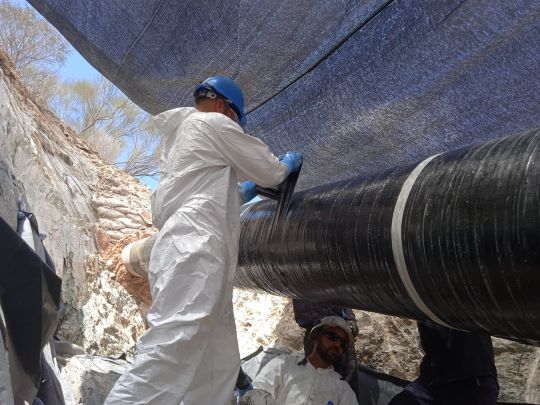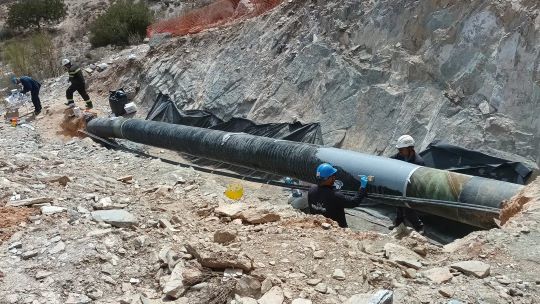In recent years, an underground oil pipeline at a Spanish refinery was suffering from severe corrosion, and it would have likely incurred severe metal loss if left unchecked.
At 872 meters (2860.8 ft) in length, disastrous consequences—both financially and from an environmental perspective—could have ensued if the corroded pipeline was not addressed.
Instead, a composite wrap solution from industrial protective coatings and composites manufacturer Belzona allowed the customer to avoid a total replacement. For purposes of this case study, the client chose to remain anonymous.
Solution Mitigates Cost and Carbon Footprint
A prompt repair was required for the carbon steel pipeline, estimated at 55.9 cm (22 in) in diameter. In fact, if left unrepaired, this would have caused the substrate to completely corrode through.
A potential solution would have been to completely replace the pipeline. However, considering its mammoth length, this process would have required considerable financial expenditure while also incurring a hefty carbon footprint.
For every ton of steel that is produced, 1.85 tons of CO2—nearly double the amount—is released back into the atmosphere (Carbon Clean). In addition to this, the process of removing and disposing of the damaged pipeline further ratchets up the carbon footprint of this process.
As well as the environmental impact of replacing the corroded pipeline, this process would also require a considerable period of downtime, Belzona explains. In turn, this would lead to further profit losses. The combination of these factors, leading to both financial and environmental costs, led the customer to seek out an alternative solution to replacing the steel pipeline.

Benefits of Composite Wrap System
Ultimately, the customer decided to repair and protect its pipeline with a combination of polymeric technology. This allowed the asset owner to bypass many of the drawbacks associated with a total replacement of the pipeline.
Elena Expósito Fernández, a Level 2 AMPP Certified Coating Inspector and technical-commercial delegate at Belzona distributor Rodator Composites, inspected the pipeline before putting together a specification and application plan.
“The 2-part epoxy paste, Belzona 1111 (Super Metal), was specified to fill in any gaps in the weld seams to ensure the pipeline had a smooth profile,” Fernández says. “For heavily corroded areas, plate bonding was required using steel plates which were 50 cm by 60 cm (19.9 in by 23.6 in) in size, with a thickness of 5 mm (0.2 in). These were bonded into place using the epoxy structural adhesive, Belzona 7311.”
“To reinforce the pipeline, the composite wrap, Belzona SuperWrap II, was specified,” she adds. “Finally, the anti-corrosion coating, Belzona 5811 (immersion grade), was chosen to provide long-term corrosion protection.”

Polymeric Technology Supports Decarbonization
In the end, the customer was able to successfully bypass many drawbacks associated with complete pipeline replacement by using a combination of polymeric technology to repair and protect the asset. In addition to huge financial savings, this solution enabled the customer to minimize its environmental impact, as well.
As the oil and gas industry continues to decarbonize, this latter point can be of increasing importance. According to Belzona, polymeric technology is an extremely viable way in which oil and gas asset managers can make strides in mitigating the carbon footprint of facilities.
As Belzona explains, an increased uptake in the use of cold-applied repair composites and protective coatings would help to accelerate the industry’s decarbonization goals.
Source: Belzona, www.belzona.com.